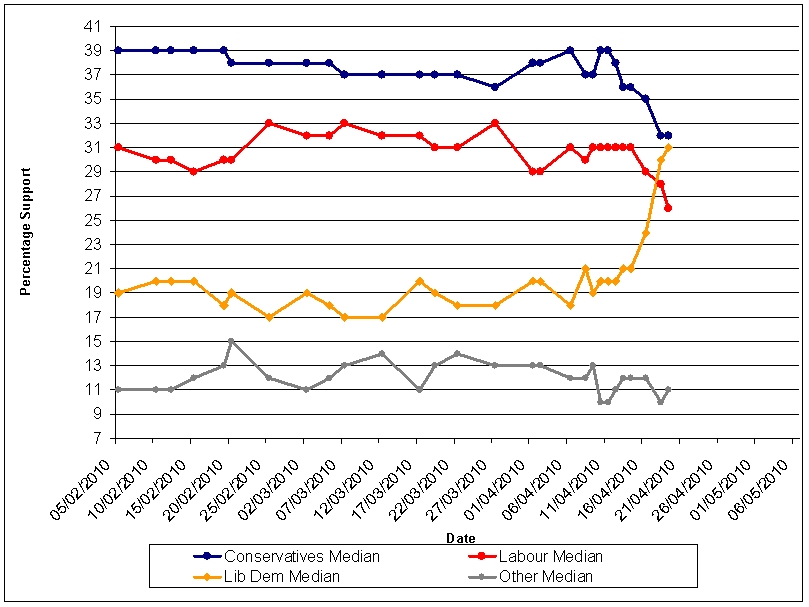Posted by Chris Gilson and Patrick Dunleavy.
Latest Poll Information for 20 April
| Party | Sky News Poll Tracking | LSE Poll Tracking | |
|---|---|---|---|
| Per cent | Per cent | Change | |
| Last Change | 20 April | 20 April | 18 to 20 April |
| Labour | 29 | 26 | -2 |
| Conservatives | 34 | 32 | -1 |
| Liberal Democrats | 26 | 31 | +2 |
| Other Parties | 11 | 11 | +1 |
| Tory Lead | +5 | +6 | +1 |
Labour and the Conservatives continue to take poll hits in almost even measure, as Nick Clegg’s Liberal Democrats rise again in our table to 31 per cent, putting it five points ahead of Labour, and only one point behind the Conservatives. This is a whole ten point jump since last Friday, when they were polling at 21 per cent.
This is certainly not now a single poll blip for the Lib Democrats. Eleven out of the 12 polls taken since last Thursday’s first TV debate have put the party at 27 per cent or above, and six of those have had them at 30 per cent or above. Over the weekend, YouGov put the Lib Dems on 33 per cent, 1 per cent above the Tories and 7 per cent above the Labour party. But even our conservatively assessed average (the median score) now shows a stellar climb – see chart below.
LSE Poll Tracking February – April 2010
Equally, however, it is well to remember that voters in Britain have ‘surged’ for outsider parties before, including
– the Liberal Democrats after by-election wins,
– the Greens in the 1989 European Parliament elections (when they got 15 per cent), and
– UKIP and the BNP at both the 2004 and 2009 European elections (when they polled nearly a quarter of votes between them).
Yet there is a big gulf between getting a surge and converting into a sustainable boost in votes that endures through to general election day in many hundreds of constituencies, as past history for all these parties proves.
That’s a gulf that Clegg and his party activists will have to do incredibly well to bridge, if they are to maintain current support levels. Perhaps it was for this reason that Peter Kellner in the Observer did not project current polls into seats but simply his guess of what the Liberal Democrats would get in the end – which was 25 per cent, against 36 for the Tories. This is suggestive – but it hardly seems a scientific way of proceeding, especially with two more debates to go, that might just as easily sustain or increase Clegg’s momentum as well as causing it to slow.
n the meantime, returning to actual numbers, the Conservatives have been reasonably steady on 31 to 33 per cent after their Friday drop of over 5 per cent. Labour still show some signs of a continuing fall, however, with several polls having them at 26 to 28 per cent. The leadership will need to stay in touch with the other two parties’ poll ratings, or there really could be a new meaning for Westminster flipping. Given that the other smaller parties are relatively stable on 10-11 per cent, it seems clear that the Liberal Democrats have managed to tap popular disenchantment with both Labour and the Conservatives – their rise of 10 per cent in the polls has been fuelled fairly evenly by drawing support from the top two parties, at least up to this point. But any public perception that Labour is really running third would be damaging in many seats.
Sky’s measure that we report above now includes some rather dated polls, and so seems to be underestimating the Liberal Democrats. We will keep an eye on this to see if it changes in the next few days to reflect the large number of polls that have the Lib Dems in the 28-32 per cent range.




